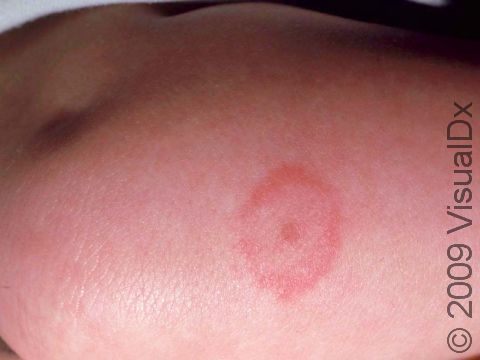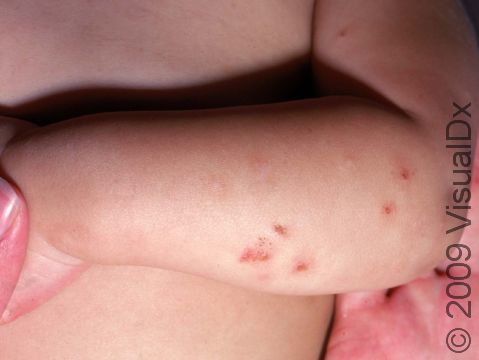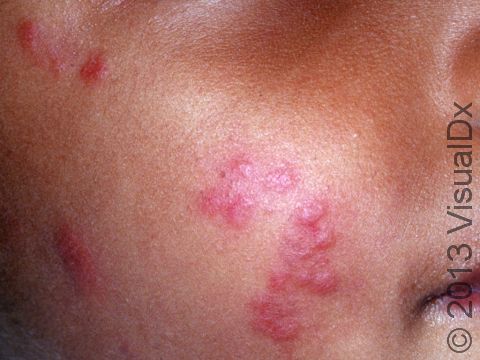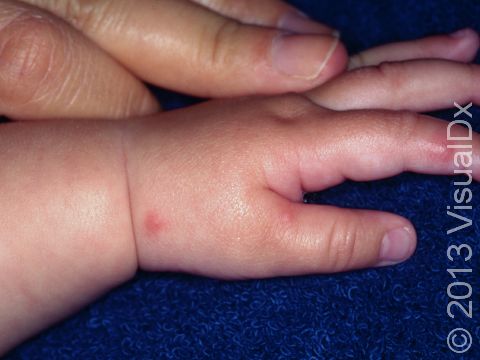Bug Bite or Sting (Pediatric)
Most bites and stings from insects (arthropods) are painful or itchy but harmless. The person who has experienced the bite or sting usually develops some pain, redness, or itchiness at the site that goes away within hours to days. People with more sensitive skin will often have a more dramatic reaction (eg, more redness or a bigger bump), but the bite is still usually harmless.
Where the bite occurs on the body can help determine what kind of insect was involved; flying insects tend to bite the head and torso, while jumping insects, such as fleas, tend to bite the feet and legs.
A very small portion of the population is allergic to the bite or sting of some common insects, such as wasps and bees, and the allergic person will experience a severe reaction, including hives (raised welts) all over their body, itchiness, trouble breathing and swallowing, and unconsciousness. An allergic reaction to a bite or sting may be fatal. If you suspect this sort of allergy in your baby, you should discuss it with their medical professional; you may need to carry a special sort of medicine that can be injected in case of emergency to reverse the allergic reaction.
Who's At Risk?
Anyone of any age can be affected by insect bites and stings. The time of year and the climate tend to dictate what kinds of insects are involved. Flying and jumping insects are more prevalent in the Eastern United States, while crawling insects are more often found in the Western United States.
There is no proven effect of age, race / ethnicity, or sex in terms of bite reactions.
Signs & Symptoms
Insect bites usually occur on the skin as small, itchy, red papules (small, solid bumps). Sometimes, vesicles (small fluid-filled blisters) may occur at the site of bites or stings. In some situations and in some locations, such as the lower leg or shin, bullae (fluid-filled blisters larger than a thumbnail) can occur. Some insects, such as fire ants, are known to cause painful, itchy pustules (pus-filled bumps). In lighter skin colors, the bites and stings may be faint pink or red. In darker skin colors, the redness may be harder to see. Using a bright light may help show any subtle color changes.
Flying insects tend to choose exposed areas not covered by clothing, while some bugs (such as fleas) focus on the lower legs. Bedbugs prefer the arms, legs, chest, and face, often biting several times in the same area and leaving a group of lesions.
Common reactions to insect stings include:
- Redness, pain, and swelling.
- Severe reactions such as facial swelling, difficulty breathing, and shock (anaphylaxis).
- Fever, hives, and painful joints (although these reactions are not as common).
Very few spiders cause severe reactions. The black widow spider may cause only a mild local reaction at the bite site, but pain, stiffness, chills, fever, nausea, and abdominal pain may follow within a few hours. Similarly, the bite of a brown recluse spider may cause a marked skin reaction after a few hours, with redness, pain, blistering, and ulcers forming, as well as fever, nausea, and fatigue.
Self-Care Guidelines
For stings:
- Bees may leave a stinger behind; if so, try to gently scrape off the stinger with a blunt object, such as a credit card.
- Wash the wound with soap and water.
- Apply an ice pack or cold water for a few minutes.
- Take acetaminophen (eg, Tylenol) for pain and apply topical anti-itch lotion (eg, calamine lotion) for itching, as needed.
For insect bites:
- Wash with soap and water.
- Apply cool compresses.
- Use antihistamines (ages 6 months and older) to relieve itching and acetaminophen for pain.
- Using 1% hydrocortisone cream can be helpful.
For ticks (still attached):
- Using tweezers, grasp the tick as near the skin as possible and pull firmly until it releases.
- Swab the area with alcohol or soap and water.
- Save the tick for identification, if needed.
- Wash the area with soap and water, then apply 1% hydrocortisone in anticipation of any reaction.
Treatments
Depending on the type of insect bite and its reaction, your baby’s medical professional may treat the baby in the following manner.
For insect bites:
- Prescription topical corticosteroids
- Muscle relaxants, pain medicines, antivenin (antivenom), antibiotics, and sometimes local surgery to relieve venomous insect bites
For stings:
- Antihistamines or corticosteroids
- Epinephrine, antihistamines, corticosteroids, intravenous fluids, and oxygen (for anaphylaxis)
- Injectable epinephrine, for those with known severe allergic reactions
- Immunotherapy to reduce the chance of repeated severe reactions
Visit Urgency
Some insect (arthropod) bites / stings are more dangerous than others. If you suspect your child might have a black widow or brown recluse spider bite, apply ice to the area and seek medical assistance immediately.
Symptoms of these bites include:
- A deep blue or purple area around the bite, often with a surrounding white
area and a red outer ring - Abdominal pain
- Headache
- Fever
- Fatigue
- Nausea
- Muscle stiffness
If the area of a tick bite becomes red or swollen, or if the affected area spreads outward, seek medical help to check for Lyme disease.
When dealing with stings, watch out for symptoms such as:
- Hives, itching, or swelling in areas beyond the sting site
- Swelling of the lips or throat
- Tightness in the chest or difficulty breathing
- Hoarse voice or tongue swelling
- Dizziness or loss of consciousness
Trusted Links
References
Bolognia J, Schaffer JV, Cerroni L. Dermatology. 4th ed. Philadelphia, PA: Elsevier; 2018.
James WD, Elston D, Treat JR, Rosenbach MA. Andrew’s Diseases of the Skin. 13th ed. Philadelphia, PA: Elsevier; 2019.
Kang S, Amagai M, Bruckner AL, et al. Fitzpatrick’s Dermatology. 9th ed. New York, NY: McGraw-Hill Education; 2019.
Paller A, Mancini A. Paller and Mancini: Hurwitz Clinical Pediatric Dermatology. 6th ed. St. Louis, MO: Elsevier; 2022.
Last modified on June 14th, 2024 at 11:48 am

Not sure what to look for?
Try our new Rash and Skin Condition Finder



